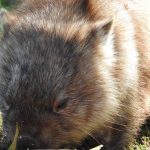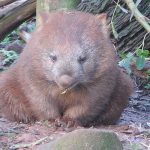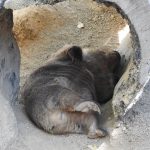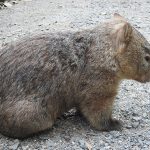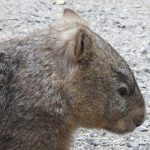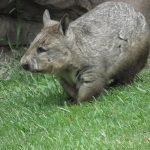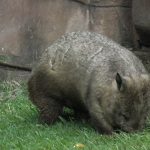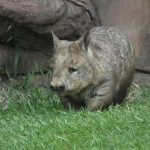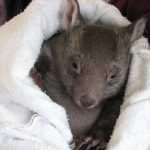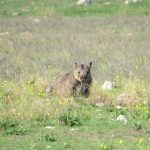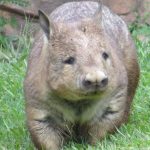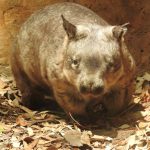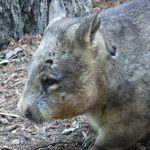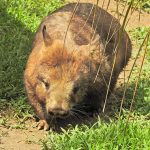WOMBATS
family Vombatidae
What is a wombat?
Wombats are burrowing marsupials native to Australia. Stocky and strong, they are expert diggers with a famously backward-facing pouch that keeps soil away from their young. Their teeth grow continuously, like a beaver’s, and their digestion is exceptionally slow, extracting maximum nutrition from tough grasses. Wombats are mostly nocturnal or crepuscular, stepping out in the cool of evening to feed.
With only three species—the Bare Nosed Wombat also known as the Common Wombat (Vombatus ursinus), the Northern Hairy-nosed Wombat (Lasiorhinus krefftii), and the Southern Hairy-nosed Wombat (Lasiorhinus latifrons)—these creatures are as unique as they are scarce.
Wombats possess a charming yet formidable appearance, characterized by their stocky build and short, powerful legs. Their compact, barrel-shaped bodies are complemented by a large, rounded head, while their strong claws are essential tools for crafting their underground havens. Despite their cumbersome appearance, wombats are surprisingly agile, capable of reaching speeds up to 40 km/h in a dash to escape predators or danger.
Why wombats matter
Wombats shape the land. Their burrows aerate soil, redistribute nutrients, and create cool refuges used by a suite of other animals. Protecting wombats safeguards a quiet but essential engineer of Australian ecosystems. When we give them space to graze and dig, we also protect the breath of the soil, the flow of underground cool, and the life that follows in their tunnels.
The Common Wombat, the largest of its kin, can stretch up to a meter in length and tip the scales at a hefty 20 to 35 kilograms. Its cousins, the Hairy-nosed Wombats, are slightly more petite, with the Southern Hairy-nosed Wombat claiming the title of the smallest among the trio.
Common Wombat by Sharon McGrigor
Wombats are equipped with a digestive system that’s a marvel of nature, perfectly adapted to break down the tough vegetation that comprises their diet. As herbivores, they feast on a selection of grasses, roots, and bark—a testament to their resilience and adaptation to the Australian bush.
When the sun dips below the horizon and dusk wraps the landscape in twilight, the nocturnal Wombats emerge to forage under the cover of night. They venture out from the safety of their burrows—complex networks of tunnels and chambers that they’ve meticulously excavated. These burrows can stretch up to 30 meters long, with intricate layouts unique to each species.
Wombats are typically solitary, content with their own company and the quiet solitude of their burrowed homes.
Reproduction for these marsupials is a slow affair. After a brief gestation of about 20 to 30 days, a female Wombat gives birth to a single joey. This tiny creature embarks on a perilous journey, crawling into its mother’s pouch where it will continue to grow and nurse for months to come.
In times of danger, Wombats exhibit a remarkable defense mechanism. They can retreat with surprising speed into their burrows, employing their muscular hindquarters and sharp claws to barricade the entrance, thwarting many would-be predators.
The Wombat, with its distinctive habits and ecological contributions, has become a beloved symbol of Australia’s natural heritage. Yet, these creatures are not immune to the perils of human encroachment. These stout marsupials are facing a barrage of threats that jeopardize their very existence.
Disease, relentless habitat loss, frequent road accidents, and the harshness of extreme weather events have converged into a lethal storm, threatening to erase the presence of Wombats from the bushlands they’ve roamed for millennia.
The Northern Hairy-nosed Wombat stands on the precipice of extinction, its status as ‘Critically Endangered’ under the International Union for the Conservation of Nature (IUCN) Red List of Threatened Species a stark reminder of its dire circumstances. This elusive creature, once a common sight, is now presumed extinct in New South Wales (NSW).
Its relative, the Southern Hairy-nosed Wombat, faces significant challenges. Classified as ‘Near Threatened’ by the IUCN and listed as ‘Endangered’ in NSW, it too feels the encroaching shadow of human impact.
Southern Hairy-nosed Wombat by Sharon McGrigor
Even the Bare-nosed Wombat, known as the Common Wombat, is witnessing its once widespread range dwindle, becoming less ‘common’ as its habitats shrink and fragment.
One of the most harrowing threats they face is mange, a life-threatening disease caused by the parasitic mite Sarcoptes scabiei. This insidious pest burrows into the wombat’s skin, causing debilitating symptoms that, if left untreated, can lead to a cruel and untimely death.
However, there is a glimmer of hope. With early detection, Wombats afflicted with mange can be treated and often make full recoveries. Efforts to combat this disease are underway, including community-based initiatives like the Community Mange Treatment Program. This program empowers local residents to take an active role in treating and protecting wombats within their vicinity.
The plight of the Wombat is a poignant reminder of the fragility of our natural world and the pressing need for conservation. By raising awareness and taking action, we can help secure a future where Wombats continue to dig through the underbrush, play their critical role in the ecosystem, and enchant future generations with their burrowing brilliance.
How to help:
- Drive cautiously in wombat areas at night; look for wildlife crossing signs.
- Report suspected mange cases to local wildlife groups.
- Keep dogs on leads near wombat habitat.
- Use wildlife-friendly fencing and provide escape ramps in water troughs.
- Support habitat restoration and organisations working on wombat conservation.
Living alongside wombats
- In rural settings, wombats may burrow under fences or sheds. Practical coexistence includes reinforcing critical structures, installing one-way gates for safe movement, and protecting house foundations with buried mesh—solutions that steer wombats without harming them.
- Never feed wild wombats; offer habitat instead by preserving native grasses and shelter.
Common Wombat with her joey by Sharon McGrigor
Quick facts
- Weight: roughly 20–35 kg (species and individuals vary).
- Speed: surprisingly quick over short bursts.
- Vision: modest; relies strongly on smell and hearing.
- Scats: typically placed on raised surfaces for scent-marking—yes, the famous cubes.
- Relatives: closest living relatives include Koalas; both are uniquely Australian marsupials.


